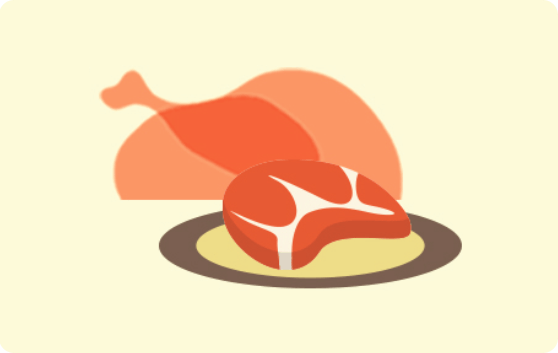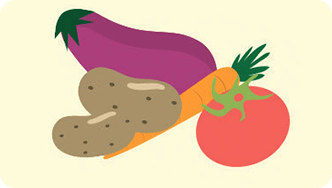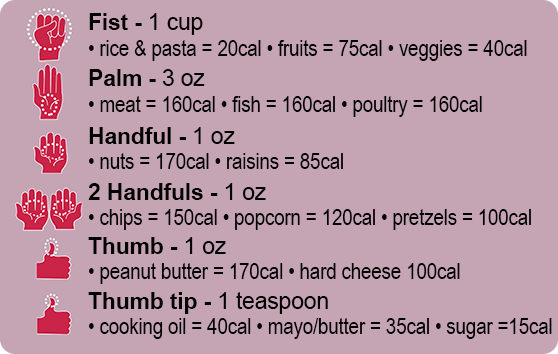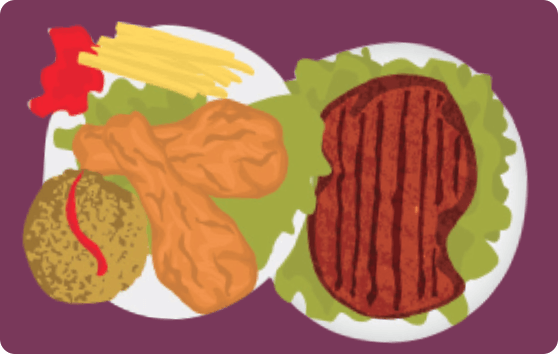What’s a good diet
Eat Smart, Get Well
Healthy lifestyle changes begins in the market and the kitchen. Let’s empower the person who buys and prepares the food.
For a healthy heart, CHOOSE MORE OFTEN:
This list must be discussed with the person who does the shopping and prepares the food for you and your loved ones.
Breads and cereals

Six (6) or more servings per day, adjusted to caloric needs.
Breads, cereals, especially whole grain, pasta, rice, potatoes, dry beans and peas, low fat crackers, and cookies
Vegetables

3-5 servings per day Fresh, frozen, or canned without added fat, sauce, or salt
Fruits

2-4 servings per day Fresh, frozen, canned (without syrup), or dried
For a healthy heart, REDUCE OF AVOID:
This list must be discussed with the person who does the shopping and prepares the food for you or you loved ones.
Dairy products

2-3 servings per day Fat-free, ½ – 1% milk, buttermilk, yogurt, cottage cheese; fat-free & low-fat cheese
Eggs

Maximum 2 egg yolks per week. Egg whites or egg substitute
Meat, Poultry, Fish

Less than 5 oz per day. Lean cuts, extra lean hamburger, cold cuts made with lean meat or soy protein, skinless poultry, fish
Fats and Oils

Amount adjusted to caloric level. Unsaturated oils, soft or liquid margarines and vegetable oil spreads, salad dressings, seeds, and nuts
Reduce or Avoid
For a healthy heart
Pastries & Baked Goods
Bakery products including doughnuts, biscuits, butter rolls, muffins, croissants, sweet rolls, etc.

Vegetables in Butter
Vegetables fried or prepared with butter, cheese or cream sauce

Fruits with sugar
Fruits served with syrup, sugar or cream

Eat Sensibly, Choose Wisely
People who consume more fruits, vegetables, whole grains, and unsaturated fatty acids reduce their risk of heart disease, heart attack, and stroke.
Eating a balance diet that includes more fruits and vegetables and less fat will help lower your cholesterol.
Eating food that has Vitamin B, Omega-3 Fatty Acids and other micronutrients can protect your heart from heart disease.

How can I easily measure my food and count the calories?
Here’s a handy guide to help you measure how much you’re eating.
Change for Healthy Eating, Change for a Healthy Heart

I am ready to change now this is my level of motivation
I will avoid second servings.
I will eat less hidden fats by reading food labels.
I will choose products lower in saturated fat and calories.
I will ask about ingredients in instant food and take-home food from the restaurant.
I will identify and eat less of excess carbohydrates such as fat-free and regular crackers, cookies and other desserts, snacks, and soft drinks.
When is the best time to act? It’s now.
High level of motivation begins with assessment of current eating habits.
Do I routinely skip some meals?
At what time do I eat my largest meal?
Where are my meals typically prepared and eaten?
A. Restaurant
B. Fast-food
C. Home
D. Work cafeteria
E. Friend’s house
Do I eat more when I’m stressed?
Are the meals I eat ordered for delivery, prepared from processed or pre-packaged food, or cooked at home?
What food do I like and dislike?
Who does the grocery shopping and who prepares my food?
What food do I find hard to cut down in my diet?
Do I know and eat the right serving sizes?
How can I make sure that I don’t overeat when dining out or eating at home?
When at home…
Eating slowly and chewing your food well helps you eat less.
Using smaller plates helps to trick your brain into thinking that you have eaten enough.
Instead of filling up on bread and desserts, go for second servings of salad, veggies and fruits.
Eating three balanced meals a day at the proper time helps to control your hunger.

When dining out…
When browsing the menu, look for healthy dishes that are low-fat, low-calorie.
Split a meal with a friend.
Avoiding up-sized drinks, juices and sodas can help cut out excess sugar.
Choose dishes that are broiled, boiled, grilled or steamed. These are prepared with less fat.

